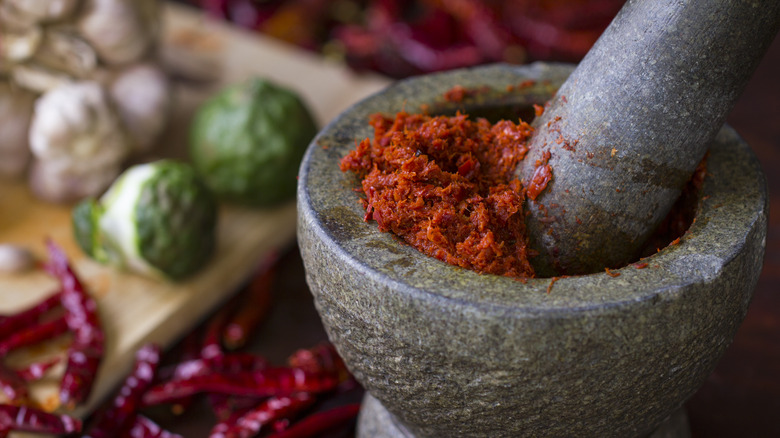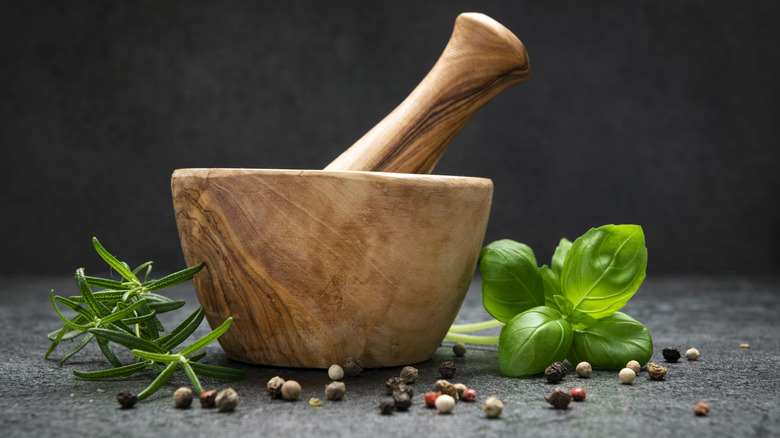What To Avoid When Buying A Mortar And Pestle
A mortar and pestle may be the most ancient cooking tool still recognizable in today's kitchens. With scores of electric and high-tech gadgets making chores quick and easy, an old-fashioned bowl and club-styled stick could have disappeared entirely — yet here it is, alive and well, regaining its honored place as a chef's culinary workhorse. When you choose the correct kind of mortar and pestle, your meals gain unexpected depth, flavor, and aroma, primarily because of how the pestle grinds the ingredients. While a food processor or sharp kitchen knife employs blades to dice, chop, or mince, a pestle instead grinds and mashes fresh herbs, nuts, garlic, ginger, chili peppers, and other necessities for the dish you're preparing. This loosens the cells, fibers, and nutrients inside each plant, letting all that goodness permeate the food.
But for this to work effectively, it's crucial to avoid certain features when purchasing a mortar and pestle. That means paying attention to the shapes and finishes of the two components, bypassing some of the trendy features in newer versions. Some nuances may be harmless, but two core elements remain essential for proper food prep. The pestle should typically be rounded or circular at the mashing end, and the interior mortar finish must retain abrasive qualities.
The finish on a mortar dictates grinding quality
Opting for a basic smasher in lieu of high-end alternatives may seem simplistic, and in many ways it is. But a mortar and pestle must have characteristics that work for rather than against you in the kitchen. For the mortar, which is the bowl portion, study its finish and avoid interiors that are glossy, slick, or excessively smooth. When grinding course dried peppers, mashing soft ingredients, or muddling mint leaves for cocktails, you don't want them sliding around inside the mortar.
Without proper traction when using the pestle, you'll fail to release and activate the aromatic flavors and oils tucked within fresh ingredients. Good choices include those made with stone, such as granite, which has a naturally abrasive texture that works hand in hand with your efforts to grind down coarse ingredients. Most commercially available stone mortar and pestles, including ones made from marble or a molcajete (made from a volcanic rock and popular in Mexican kitchens) come pre-seasoned, refined, and finished for food safety. But it's always good to double-check that they're ready to go. Softer wood mortars can be a viable option for muddling delicate herbs and soft avocados, but avoid woods with shiny varnished finishes that can wear down over time and end up in your food. Instead, find ones treated with natural food-grade oils. To avoid mold and splitting, wood mortars and pestles also require attentive drying after each use.
Shape matters with a mortar and pestle
When buying a mortar and pestle, the cylindrical pestle comes with its own criteria to consider. Specifically, shape matters — a lot. First of all, you want it to be long enough to comfortably reach the bottom of the mortar bowl. This means you can muddle or mash to your heart's content while also protecting your hand from getting bruised against the rim of the mortar.
Equally important for ease and effectiveness is to have a pestle with a substantial head at the mashing end. Avoid skinny ones that limit the quantity you can grind and the quality of the results. With a few exceptions, you'll also need the bottom to be rounded for rocking gently rock back and forth and achieving a smooth, even blend. Since most mortar bowls are round, it helps for the pestle to also have a round mashing end. A flat, square pestle bottom would make it impossible to mash and glide around the mortar's circular shape.
Any exception to this is when you're working with hard spices in large quantities. In this case, a flat-bottomed pestle and a good bit of manual labor can get the job done quickly. Some flat-end pestles are made specifically for muddling cocktails into a single glass rather than into a mortar. These often have serrated edges at the bottom. These pestles often get the job done quickly but could damage delicate mint or basil leaves, and they're often difficult to clean.


